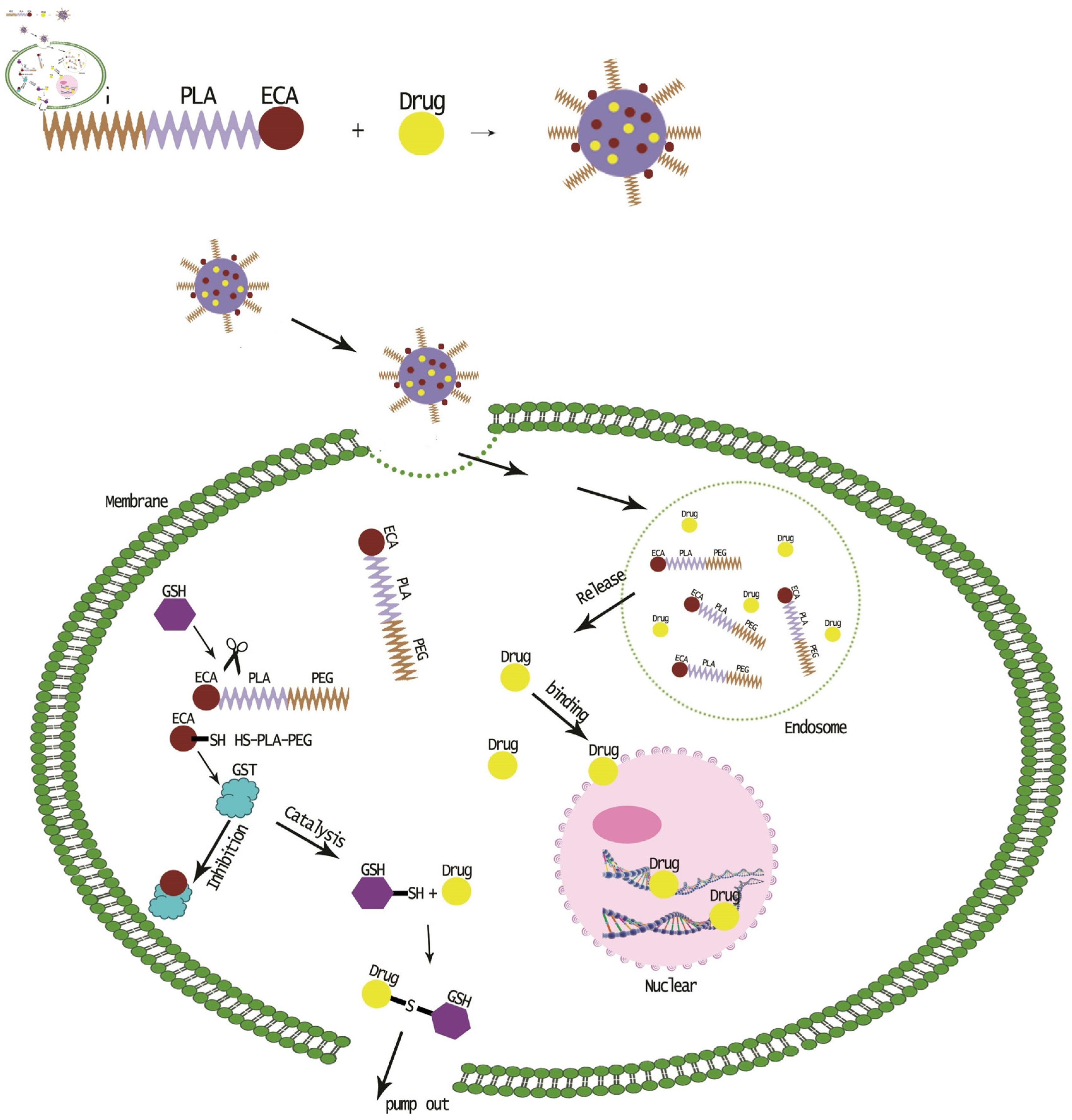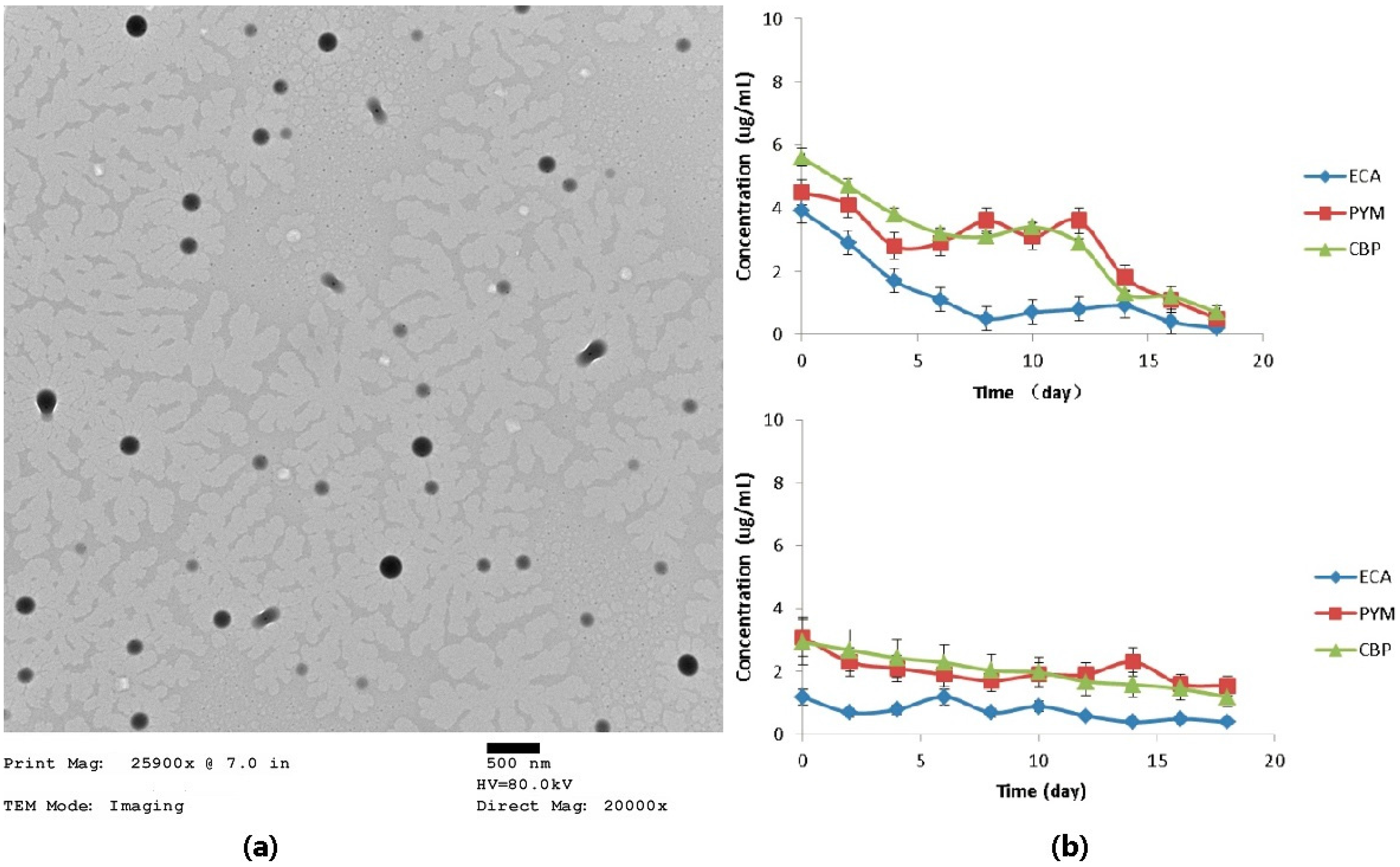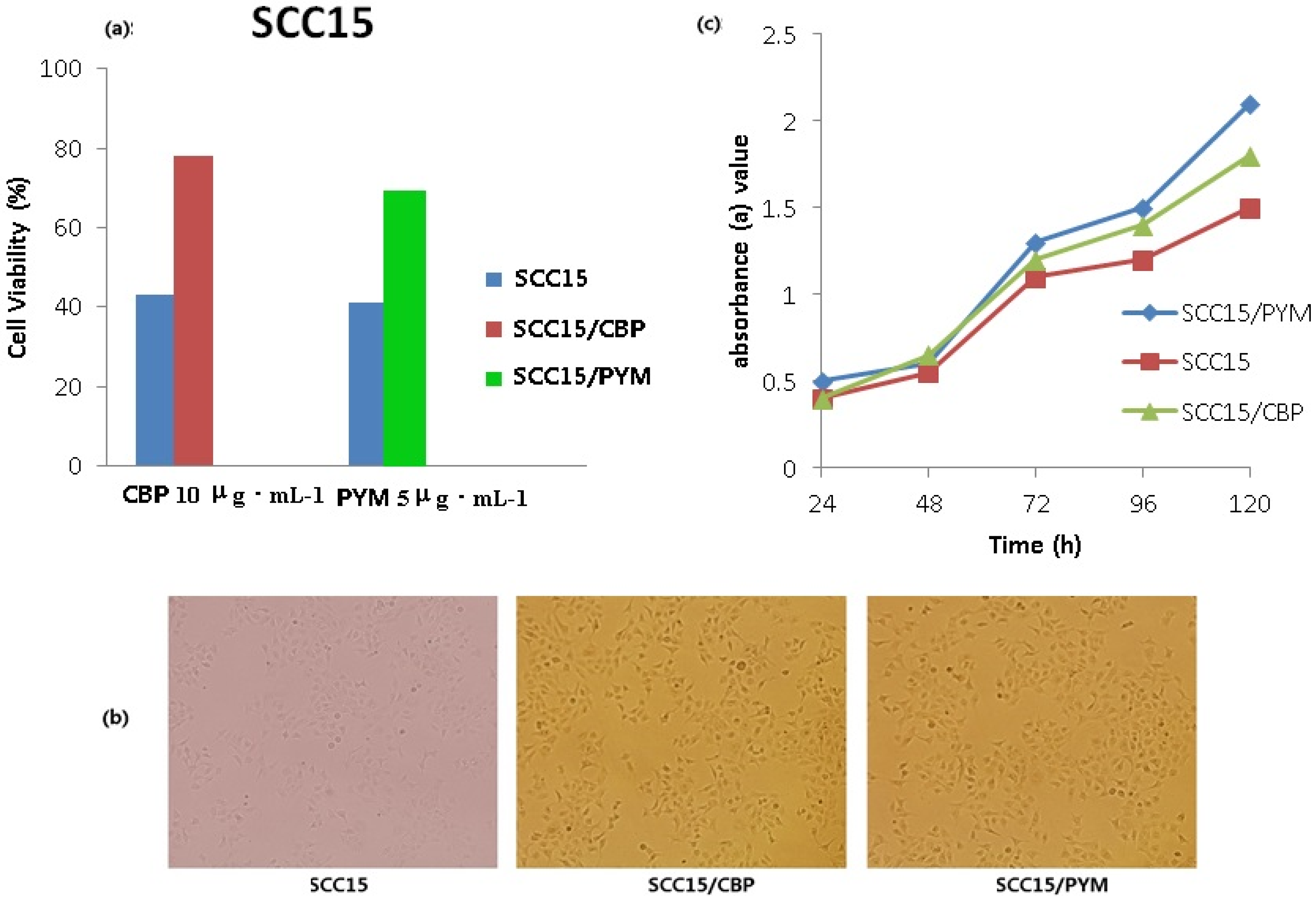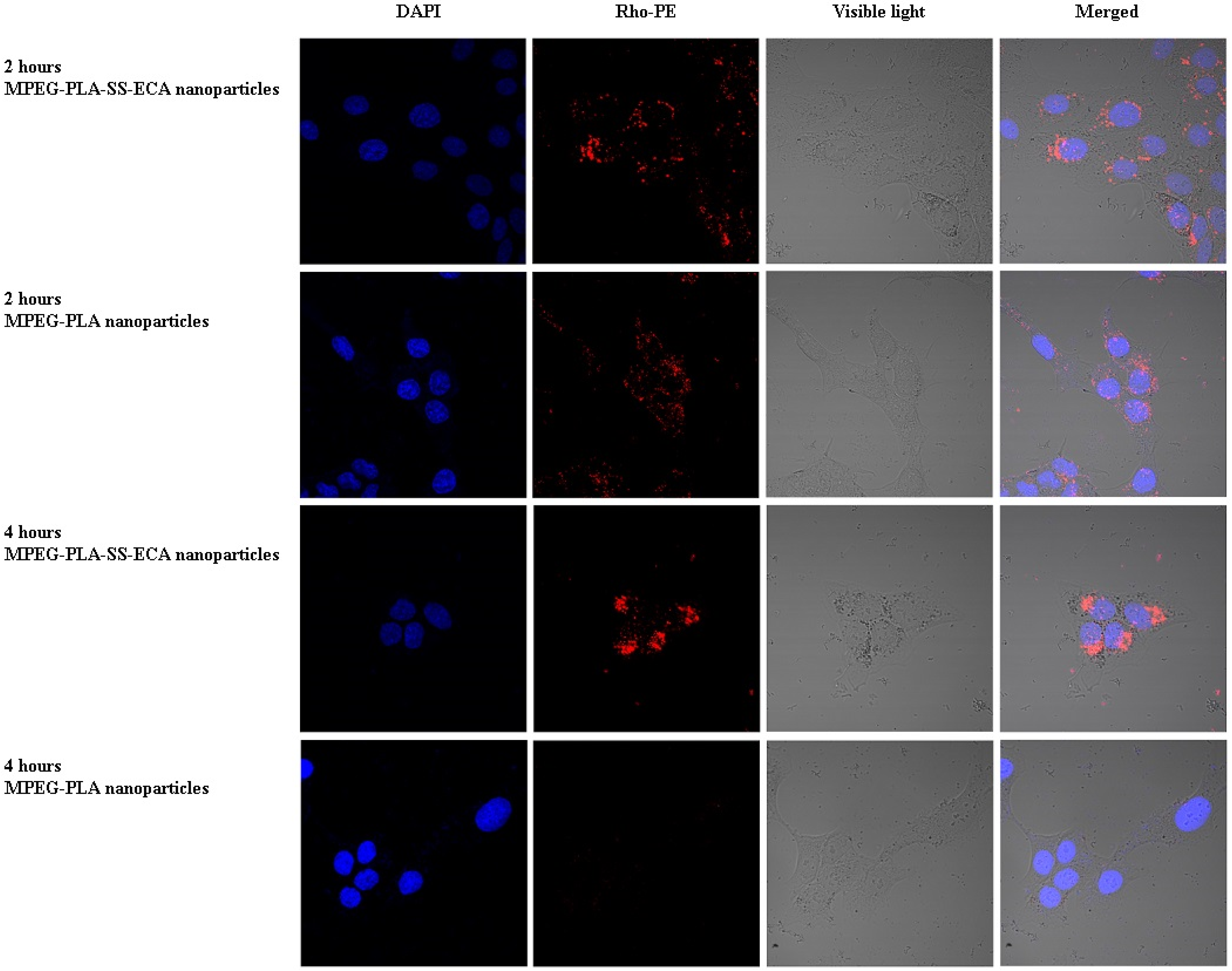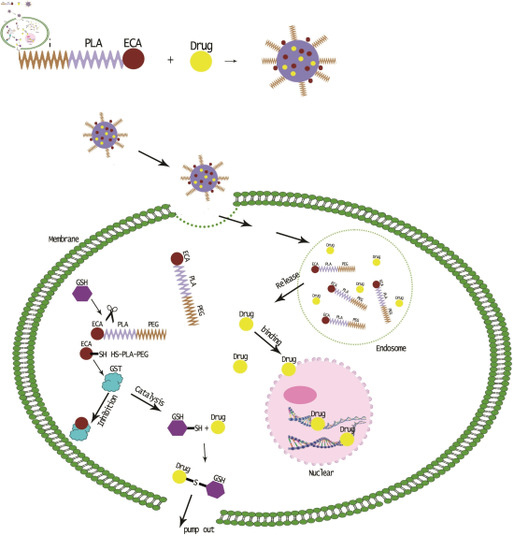1. Introduction
Malignant tumors are still the primary diseases to seriously threat human health and life today. Studies have shown that the formation of tumors is a constantly cumulative process involving more factors, and more stages. Chemotherapy remains the most primary means for the treatment of tumor so far, so that the individual difference in the therapeutic effect of chemotherapeutic drugs is significant since there are great differences in chemotherapeutic drugs used for the treatment of tumors. The medication targeting each different individual tumor, based on the existing unified clinical experience, easily leads to the primary resistance of tumor cells to chemotherapeutic drugs [
1]. The development of drug-induced multidrug resistance (MDR) of tumor tissues during the course of chemotherapy seriously affects the therapeutic effect of tumors. It is difficult for the resistance of tumors to be reversed once it develops, which means a failure of the treatment, and furthermore the development of multidrug resistance may indicate a cross resistance of tumor cells that are never exposed to other antitumor drugs, resulting in the ineffectiveness of tumor treatment in patients with tumors [
2,
3]. Oral squamous cell carcinoma is one of the common malignant tumors in the head and neck, its mortality is ranked sixth of all tumors, and chemotherapy has played an important role in the treatment of oral cancer, including the preoperative induction chemotherapy, postoperative chemotherapy, palliative chemotherapy for advanced tumor,
etc. It is particularly common for oral squamous carcinoma cells to develop resistance, leading to failure in chemotherapy, which may be the main cause for the recrudescence of oral squamous cell carcinoma [
4,
5,
6,
7]. Due to the affection of various factors, such as types of the chemotherapeutic drugs, tumor types, tumor differentiation stages, and drug targets, administration ways, and interactions between the drugs and their targets, the drug-resistant phenotypes of tumor cells are not the same, and
in vivo and
in vitro studies have found that the mechanism of multidrug resistance in oral cancer is a complicated process in which a variety of factors are involved, such as related protein expression, enzyme mediation, gene mutation, and expression deletion of stem cell targets [
6,
8,
9,
10]. Currently, studies both at home and abroad, focus primarily on the following aspects: the decrease in the intake of drugs by cells, increase in the efflux of drugs by cells, change in the cell apoptosis-related pathway, change in the drug targeting molecules, enhanced DNA repair mechanism and increase in activities of the drug metabolic enzymes in tumor cells, of which glutathionine-S-transferase (GST) that can catalyze glutathione to bind chemotherapeutic drugs to form different complexes that can be transported out of the cells as the substrates of MRP1, one of the most important multidrug resistance genes [
11,
12,
13,
14,
15]. The involving of GSH in the multidrug resistance in cancer cells is currently believed to be related to multidrug resistance-associated protein (MRP) and glutathione-S-transferase. GSH (glutathione), a naturally synthesized peptide in the cytoplasm of human beings is composed of glutamic acid, cysteine and glycine, contains thiol, and is an important component of intracellular antioxidant system, and, moreover, it can bind to many electrophilic drugs and poisons as a major intracellular electron donor. GST itself can bind to many lipophilic drugs, thus promoting the detoxification and efflux of anticancer drugs. Therefore, the inhibition of GST activities is a more significant and direct way to reduce the multidrug resistance of tumors. In addition, there is a significant difference in the redox potential between inside and outside cells, showing a partial oxidation outside cells and a partial reduction inside cells [
13,
14,
16]. GSH/(GSSG) is the main redox couple in animal cells and makes the cells have antioxidant capacity. The content of intracellular GSH is 2–3 orders of magnitudes higher than that of GSH in extracellular fluid [
17,
18]. In addition, it has been found that the intracellular concentration of GSH in cancer cells is generally elevated, several times higher than those in normal cells [
19]. Based on these different points, redox-sensitive polymers, biological connectors and nano-carrier containing disulfide bonds have attracted much public attention in many fields in the past few years.
In this study, ethacrynic acid (ECA), a GST inhibitor, was coupled with poly (ethylene glycol)-poly (lactic acid) (MPEG–PLA) through disulfide bonds to prepare a redox-sensitive polymer MPEG–PLA–SS–ECA, and the polymer could self-assemble for the preparation of nanoparticles. Both the solubility and stability of the drug in the form of the prepared nanoparticles could be increased by the modification of the polyethylene glycol on the surface of the nanoparticles. The duration of the drug with a small particle size in the body and the concentration time of it at the tumor site could be ensured to be lengthened; that is, enhanced permeability and retention effect (EPR) [
20,
21]. By introducing the disulfide bond that could be cleaved by cysteine, the targeted release of GST inhibitors can be achieved to reverse the multidrug resistance in tumor cells. Human oral squamous cell carcinoma SCC15 cells were used for the study, in which SCC15/PYM and SCC15/CBP cell strains resistant to the chemotherapeutic drugs pingyangmycin (bleomycin) and carboplatin commonly used for oral squamous cell carcinoma were induced, respectively, and the pingyangmycin and carboplatin were encapsuled with MPEG–PLA–SS–ECA to prepare MPEG–PLA–SS–ECA/PYM and MPEG–PLA–SS–ECA/CBP nanoparticles, respectively. The prepared nanoparticles could accumulate in the tumor cells to effectively reduce the expression of GST protein in tumor cells and reverse the resistance of the drug-resistant cell strains (
Scheme 1).
Scheme 1.
Reversal effect of glutathionine-S-transferase (GST) inhibitor nanoparticle drug delivery system on the multidrug resistance in cancer cells.
Scheme 1.
Reversal effect of glutathionine-S-transferase (GST) inhibitor nanoparticle drug delivery system on the multidrug resistance in cancer cells.
3. Experimental Section
3.1. Reagents
Pingyangmycin (Pym, Harbin Laiboten Pharmaceutical Co., Ltd, Harbin, China); carboplatin (Shandong Boyuan Co., Ltd, Jinan, China); MPEG–PLA-OH (Jinnan Daigang Biotechnology Co., Ltd, Jinan, China); Stannous octoate (Sn(Oct)2, 95%, Sigma, Carlsbad, CA, USA); methoxy polyethylene glycols (MPEG2000, Sigma, Carlsbad, CA, USA); 4-dimethylaminopyridine (DMAP, Fluka, Buchs, Switzerland); Pyrene (98%, Acros Organics, Brussels, Belgium); cysteamine hydrochloride (Acros Organics, Brussels, Belgium); carbonyl diimidazole (CDI, Sigma, Carlsbad, CA, USA); cystamine hydrochloride (Fluka, Buchs, Switzerland); dicyclohexylcarbodiimide (DCC, Sigma, Carlsbad, CA, USA); glutathione (GSH, Sigma, Carlsbad, CA, USA); N-hydroxysuccinimide ester (NHS, Sigma, Carlsbad, CA, USA); thiourea (Aladdin, Shanghai, China); thioglycolic acid (TGA, Aladdin, Shanghai, China); succinic anhydride (Acros Organics, Brussels, Belgium); anhydrous DMSO and anhydrous dioxane (Acros Organics, Brussels, Belgium); glacial acetic acid (analytical grade, Sinopharm Chemical Reagent Co., Ltd, Shanghai, China); dichloromethane and acetone (Sinopharm Chemical Reagent Co., Ltd, Shanghai, China); other reagents all are of analytical grade. Dialysis bag (MWCO = 3500, Nanjing Senbeijia Biological Technology Co., Ltd, Nanjing, China); silica gel plate GF254 (Shanghai Jining Industrial Co., Ltd, Shanghai, China). Thiophene (MTT, sigma, Carlsbad, CA, USA); RPMI medium 1640 (1×) liquid (GIBCO, New York, NY, USA); fetal calf serum DMEM medium (GIBCO, New York, NY, USA); thiazolyl blue tetrazolium bromide (MTT) (Shanghai Shifeng Biological Technology Co., Ltd, Shanghai, China); trypsin solution (GIBCO, New York, NY, USA); formic acid (Sinopharm Chemical Reagent Co., Ltd, Shanghai, China); Hoechst 33342 (Fluka, Buchs, Switzerland); dimethyl sulfoxide (DMSO, Sinopharm Chemical Reagent Co., Ltd, Shanghai, China); human oral carcinoma cell carcinoma SCC15 cells (provide by School of Stomatology, Jilin University, Changchun, China).
3.2. Synthesis of MPEG–PLA–SS–ECA Polymer
MPEG–PLA was placed in a flask, dissolved in 30 mL DCM, mixed at 0 °C, and 0.2 mol TEA was added to it; then, 0.25 mol TsCl and 12% DMAP were dissolved together in anhydrous DCM, which was dripped into the above system to react in ice bath for 6 h, and then stirred to react at room temperature overnight. It was concentrated under reduced pressure at room temperature, and then the concentrate was dissolved in 1000 mL anhydrous ether for its precipitation and suction filtration. The filtration was wetted and washed with anhydrous ether, and then dried to obtain a white dried product with a yield of 95%. The white product was dissolved in anhydrous DMSO, to which 5-fold volume of cystamine hydrochloride, 5-fold volume of TEA and 10% of DMAP were added and mixed, reacting at 38 °C. After the reaction was completed, the reaction liquid was poured into 1000 mL cold ether for the precipitation. The precipitate dissolved in 200 mL DMF was dialyzed in a dialysis bag for 24 h, which was frozen dry to get a product MPEG–PLA–NH–CH2–CH2–SS–CH2–CH2–NH2 with a yield of 76%. The lyophilized product was detected by nuclear magnetic resonance. The synthetic routes are shown in the following figure.
An appropriate amount of MPEG–PLA–NH–CH2–CH2–SS–CH2–CH2–NH2 was dissolved in anhydrous dichloromethane, and then 10% DMAP and one-time volume of ECA–CDI was added to it, which was stirred at 38 °C for 36 h. The part of the solvent volatilized by rotary evaporation was poured into cold ethyl ether for the precipitation to separate out a yellow floccule. The solution was filtrated to obtain a precipitate, and the precipitate was mixed with ethanol and ether at a volume ratio of 1:2 for its dissolution. The precipitate was dissolved in a small amount of DMF and then dialyzed, which was freeze-dried to obtain the final product, MPEG–PLA–SS–ECA, with a yield of 35%. The lyophilized product was detected by nuclear magnetic resonance.
3.3. Preparation of Self-Assembled MPEG–PLA–SS–ECA Nanoparticles
The drug-loaded nanoparticles were prepared by single emulsion-solvent evaporation method. Two hundred milligrams of the lyophilized MPEG–PLA–SS–ECA were dissolved in 5 mL mixed liquid of DMSO and dichloromethane for 0.5 h. After the dissolution was completed, the solution was placed in an ultrasound device, and then 30 mg of pingyangmycin and carboplatin were, respectively, dissolved in the mixed liquid of DMSO and dichloromethane, which were put in ice water bath for the ultrasound for 4 min at 450 w ultrasound strength. The organic solution was removed by rotary evaporation at a mixing speed of 300 rpm for 4 h, and the residual was centrifuged at 2000 g for 15 min to obtain nanoparticles in it and the nanoparticles were frozen dry. Pingyangmycin-, carboplatin- and nondrug- loaded MPEG–PLA–SS–ECA nanoparticles were prepared in this way, and the prepared nanoparticles were used for the subsequent tests.
3.4. Detection of Physicochemical Properties of MPEG–PLA–SS–ECA Nanoparticles and Study on ECA Release
The nanoparticles were observed by TEM, their apparent forms were analyzed and their particle sizes were measured with a nanoparticle size analyzer. The phosphate buffer at pH 7.4 was used as the
in vitro drug release medium of MPEG–PLA–SS–ECA nanoparticles. Five milligrams of nanoparticles were put in a dialysis bag, and then the dialysis bag was placed in a 10 mL PBS medium and vibrated at 37 °C under a constant temperature (80 r/min) for the observation on
in vitro release [
30,
31,
32]. The samples were taken out at a certain interval, and 10 mL of the release medium were taken out completely and then 10 mL of the fresh medium were supplemented. The optical absorbance (OD) of release media at the maximum absorption peak at each time point was detected by UV-vis spectrophotometer, and the cumulative release percentage of ECA was calculated based on the standard curve. In order to determine the effect of GSH on the dissociation of disulfide bonds in the polymer materials, a PBS release medium containing 10 mM GSH was used for the observation. The specific procedures were the same as those described above and the cumulative release percentage of ECA was calculated based on the standard curve.
3.5. Study on Drug Delivery Properties of the MPEG–PLA–SS–ECA Nanoparticles
PBS release medium and PBS release medium containing 10 mM GSH were used as the delivery systems, respectively. Five milligrams of pingyangmycin- and carboplatin-loaded nanoparticles were put into dialysis bags, respectively, and then the dialysis bags were placed in a 10 mL PBS medium and vibrated at 37 °C at a constant temperature (80 r/min) for the observation on the
in vitro release. The samples were taken out at a certain interval, and 10 mL of the release medium were taken out completely and then 10 mL of the fresh medium were supplemented. The drug release concentrations were detected by HPLC and the drug release curves were drawn [
30,
33]. Based on the standard curves, the cumulative release percentages were calculated, and the drug-loaded amounts of nanoparticles were calculated according to the administration dosage of drug.
3.6. Study on the Induction and Identification of Drug-Resistant Cells
After they were thawed and resuscitated, SCC15 cells were cultured at 5% CO2-saturated humidity and 37 °C in RPMI-1640 medium (including 10% calf serum, 1.5 g sodium bicarbonate, and 100 μg·mL−1 of penicillin and streptomycin). Carboplatin and pingyangmycin were used to induce the cells and the drug concentration in the culture medium was from 0.3 µg·mL−1; after the culture for 3 day, the medium was replaced by the normal medium and the cells were cultured in it for 2 d; when the cells grew into flakes, the drug concentration was progressively increased consecutively for 6 months until SCC15 could normally grow and passage when the mass concentration of carboplatin was maintained at 10 μg·mL−1 and that of pingyangmycin at 5 μg·mL−1, namely, the cells became drug-resistant human tongue squamous cell carcinoma cellsSCC15/CBP and SCC15/PYM.
MTT assay was used to identify the drug-resistant cells. The induced SCC15/CBP and SCC15/PYM adherent growth cells were prepared into a single cell suspension, and the cells in the single cell suspension were seeded in 96-wellplates, in which a blank control group and a negative control group were set, and 3 duplicate wells were set in each group; after the cells were cultured under conditions of 5% CO2 and 37 °C for 24 h, the medium was replaced by the fresh medium containing 10 μg·mL−1 of carboplatin and 5 μg·mL−1 of pingyangmycin, and then the cells were cultured again in 5% CO2, at 37 °C for 72 h; absorbances (A) of all the wells were detected at 570 nm wavelength by MTT assay for the calculation of cell survival rates.
Immunohistochemical method was used to detect the expression of P-gp in the cells and identify whether the induction of cells was successful or not. The cell growing on the glass was washed 3 times with PBS for 5 min each time, and treated with 0.25% Triton X-100 processing for 10–15 min; the extra liquid was abandoned and then the glass was washed 3 time with PBS; 3% H2O2 solution was used to block the endogenous peroxidase for 5–10 min, and then the glass was washed 3 times with PBS; mouse anti-human P-gp monoclonal antibody (1:100) was dripped on the glass at 37 °C for 2 h; the biotinylated secondary body was dripped on the glass for the incubation of the cells at 37 °C in a wet box for 0.5 h, and then the glass was washed 3 times with PBS; the biotinylated third antibody was dripped on the glass to incubate with the cells at 37 °C in a wet box for 0.5 h, and the glass was washed 3 times with PBS; the glass was stained with DAB and washed with water, then the color separation, dehydration, and transparentizing of glass were conducted, and finally the glass was observed under a microscope after it was mounted.
Growth characteristics of the drug-resistant cells were observed. The induced adherent growth cells were prepared into a single cell suspension, and the cells in the single cell suspension were seeded in 96-wellplates, in which a blank control group and a negative control group were set, and 3 duplicate wells were set in each group; the cells were cultured in 5% CO2 and at 37 °C for 24 h, then the medium was replaced by the fresh medium containing 10 μg·mL−1 carboplatin and 5 μg·mL−1 pingyangmycin, and the cells were cultured in 5% CO2 and at 37 °C for 24, 48, 72, 96, and 120 h, respectively, and finally A values of all the wells were detected with MTT method and the cell growth curves were calculated based on the A values and the culture time.
3.7. Study on Nanoparticle Endocytosis of the Cells
The in vitro uptake of MPEG–PLA–SS–ECA nanoparticle by the drug-resistant cells was observed and located under a confocal laser scanning microscope (CLSM). First the pingyangmycin was replaced by rhodamine, and then a rhodamine-labeled MPEG–PLA–SS–ECA nanoparticle was prepared in accordance with the nanoparticle preparation methods mentioned above. The induced drug-resistant oral squamous cell carcinoma cellsSCC15/PYM was seeded at a density of 105/well in small confocal dishes, respectively. Twenty-four hours later, MPEG–PLA–SS–ECA and MPEG–PLA nanoparticles in solution were placed into the media containing drug-resistant oral squamous cell carcinoma cellsSCC15/PYM cells at the different time points, in which at the specified time points (0.5, 1, 2 and 4 h, respectively), 5 μg·mL−1 of the nanoparticles (calculated at 5 μg·mL−1 of frozen dry nanoparticles) were added to them; nearing 10 min of the observation, 100 μL of hochest 33342 were added to dye the nucleus of cells, then the cells were washed three times with PBS and fixed with 4% paraformaldehyde for 10 min; the fixing solution was removed and PBS was added to them, and then CLSM was used for the observation.
3.8. Effects of MPEG–PLA–SS–ECA Nanoparticles on MDR of the Drug-Resistant Cells
Effects of MDR MPEG–PLA–SS–ECA nanoparticles on the resistance index of drug-resistant cells were investigated. The induced inherent SCC15/CBP and SCC15/PYM cells were prepared in to a single cell suspension, and the cells were seed in 96-well plates, in which a blank control group and a negative control group were set, and 3 duplicate wells were set in each group; The cells were cultured in 5% CO2 and at 37 °C for 24 h, and then 0, and 5, 10, 15, 20, 25 μg·mL−1 mass concentrations of chemotherapeutic drugs and MPEG–PLA–SS–ECA nanoparticles containing the same mass concentrations of the chemotherapeutic drugs were added to the media in the wells, respectively; 72 h later, survival rates of the cells were detected with MTT assay. Based on the survival rate, values of the half maximal inhibitory concentration (IC50) were calculated, and then based on the IC50, the reversal fold (RF) were calculated. The formulas for the calculation are as follows: RF = IC50 of common drug (pingyangmycin or carboplatin)/IC50 of drug-loading MPEG–PLA–SS–ECA nanoparticles (pingyangmycin or carboplatin). The above experiment was repeated 3 times.
3.9. Detection of the Expression of GST-π Protein in Drug-Resistant Oral Squamous Cell Carcinoma Cells
Oral squamous cell carcinoma SCC15/CBP and SCC15/PYM cells growing in the logarithmic growth phase were seeded in 100 mm plates and a control group (DMSO without drug) was set; on the next day, the drug (Pingyangmycin or carboplatin) and the drug-loaded nanoparticles containing the same concentration of the drug (pingyangmycin or carboplatin) were added to the plates, which was incubated for 24 h, and then cells in the different groups were collected for the extraction of full protein; the protein concentrations in the different groups were determined and equilibrated, and after the denaturation of the protein, the samples were kept at −70 °C with cryopreservation for Western-blot testing. Forty micrograms of the protein were loaded and electrophoresed by 10% SDS-PAGE gel electrophoresis, then the electrophoretic transfer was carried out and the membrane was blocked in 5% skim milk for 2 h; the membrane was incubated with the primary antibody rabbit anti-human (GST-π (1:500); β-actin (1:1500)) antibody at 4 °C overnight, washed 3 times for 10 h with TBST, incubated with the secondary body sheep anti-rabbit (GST-π (1:2500); β-actin (1:2500)) at room temperature for 1.5 h, washed with TBST again, and the color was developed with ECL. The images were obtained, recorded and analyzed by an image Quant LAS4000 imaging system.
